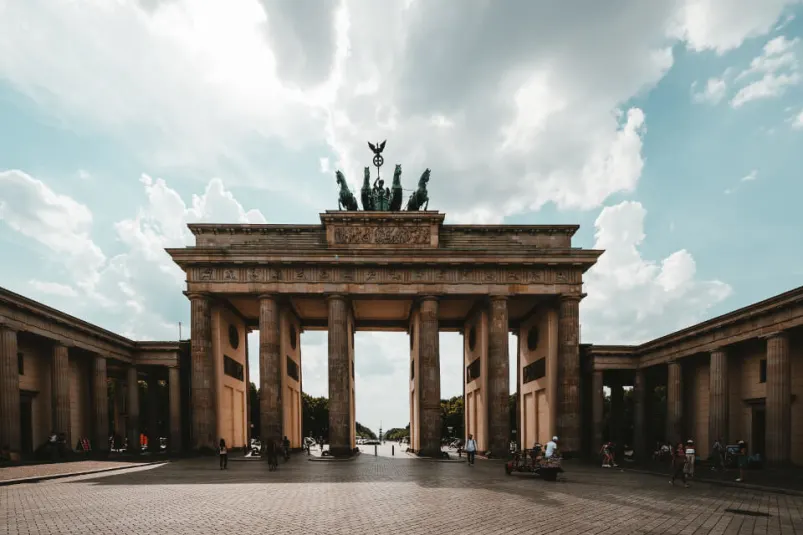Brandenburg Gate - A must-see Monument in Berlin

The Brandenburg Gate is a must see on any visit to the capital and is the emblem of Berlin. It stands on the Pariser Platz, next to the Max Liebermann Haus on its left and the Haus Sommer on its right, and is historically and architecturally one of Berlin's most interesting monuments. Day and night, visitors are eager to immortalize their stay with a selfie in front of the triumphal gate.
History of this iconic gate
Built in 1788 by Carl Gotthard Langhans on the model of the monumental gate adorning the entrance to the Acropolis in Athens, the Brandenburg Gate (Brandenburger Tor in German) is almost 30 metres high and is supported by 12 Doric columns. Five years after its construction, it was crowned by a bronze Quadriga, designed by Johann Gottfried Schadow, which represents an ancient two-wheeled chariot, harnessed to four horses, led by the goddess of victory.
The Brandenburg Gate has been a landmark and a strong symbol of the history of Germany and its capital for more than two centuries. Its majestic arches have seen royalty, Napoleon's troops, demonstrations and a number of Nazi parades over the years, before being virtually abandoned during the Cold War.
A gate in no-man's-land...

Brandenburg Gate, 1988 (Bundesarchiv, B 145 Bild-F079009-0032 / CC-BY-SA 3.0)
The post-war division of Germany (and Berlin) in 1946 assigned the Brandenburg Gate to the Soviet sector. The construction of the Wall in 1961 placed the Gate in a no man's land, making it inaccessible. Only a few brave visitors (from Berlin West) stood on the observation platform to look across the Iron Curtain.
A door to a reunited Germany
After the fall of the Berlin Wall in 1989, East and West Germans came together and celebrated the first New Year of reunified Germany. Since then, the Brandenburg Gate has finally regained its rightful place and remains one of the most remarkable symbols of the unified Germany - as we know it today.
Historical tour: From the Brandenburg Gate to the Reichstag
The tall sculptures of the Brandenburg Gate invite you to stroll along the boulevard Unter den Linden and to visit the many sights along the Tiergarten park promenade.
Example of a 30-minute walk starting at the the Brandenburg Gate and the Reichstag.
The Brandenburg Gate, the memorial to the murdered Jews of Europe, the statue of the Amazon on horseback, the memorial to the victims of the Wall, the Soviet War Memorial and finally the Reichstag can be visited.
5 Fun facts about the Brandenburger Tor:
- A quadriga that travels - When Napoleon took Berlin in 1806, he took the Quadriga with him to Paris as a trophy and symbol of Prussia's submission. After Napoleon's abdication in 1814, the Quadriga returned to decorate the Brandenburg Gate.
- A closed gate for 28 years - In the time of divided Germany, the Brandenburg Gate was placed in the path of the Berlin Wall, so that Ronald Reagan's speech of 12 June 1987 commanding his Cold War opponent Gorbachev to bring down the Wall was perfectly audible to the people of East Berlin.
- Imitated but never equalled - The Quadriga visible today is actually a copy made in 1969 - the original was destroyed during the Second World War.
- From left to right and then from right to left: true or false? It is said that over time, the Quadriga was reoriented several times. Looking initially to the west and then to the east after Napoleon, the Nazis would have turned the Quadriga to the west so that it faced France. This is actually a legend. Archive photos of the Brandenburger Tor during the war show the chariot ready to set off towards the Avenue Unter den Linden, i.e. towards the east. However, this story shows the symbolic importance of this monument.
- Known and recognised - symbolically strong, the Brandenburg Gate is often used as a political symbol. Let us recall Kennedy's intervention ("Ich bin ein Berliner") in 1963, then 50 years after President Barack Obama's intervention, which brought together more than 200,000 people.
Map, Address and how to get to the Brandenburg Gate
Map of the Berlin Brandenburg Gate

Raphaëlle Radermecker
Author
With a curious personality and a passion for well-chosen words, writing and discovery are my two passions. Berlin intrigues and fascinates me, with its cultural and artistic richness, its modernity and its ability to constantly renew itself.